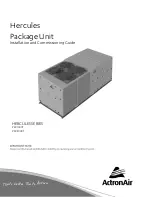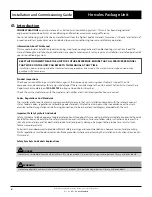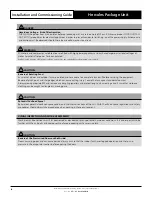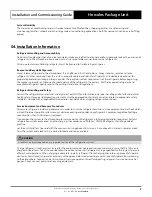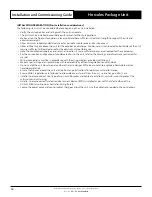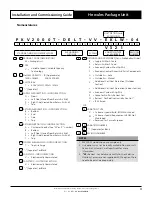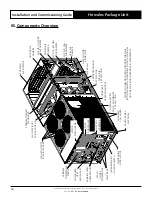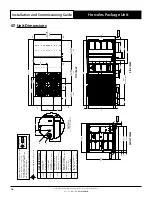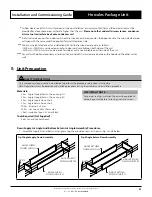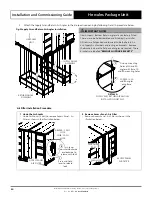
Installation and Commissioning Guide
Hercules Package Unit
9
Installation and Commissioning Guide - Hercules Package Unit
Doc. No.0525-021
Ver. 21 221110
System Flexibility
The Hercules air conditioning range is the ideal choice for offi ce facilities, shopping centres, manufacturing and
warehousing facilities, schools and other large scale air conditioning applications, both for new construction or retrofi tting
project.
04. Installation Information
Refrigerant Handling and Accountability
ActronAir strongly urges that all service technicians make every eff ort to eliminate and/or vigorously reduce the emission of
refrigerants to the atmosphere. Everyone must act in a responsible manner to conserve refrigerants.
All service technicians handling refrigerant must be licensed to handle refrigerant gases.
Recover and Recycle Refrigerants
Never release refrigerant to the atmosphere! It is an off ence in Australia to do so. Always recover, recycle and reuse
refrigerants. When removing from the system, properly contain and identify refrigerants in its dedicated container for
proper disposal and/or storage. Always consider the recycle or reclaim requirements of the refrigerant before beginning
the recovery procedures. Obtain a chemical analysis of the refrigerant if necessary. For the recovered refrigerant and
acceptable refrigerant quality refer to the existing standards and regulations.
Refrigerant Handling and Safety
Consult the refrigerant manufacturer’s safety data sheet (SDS) for information on proper handling and to fully understand
health, safety, storage and disposal requirements. Use the approved containment vessels and refer to appropriate safety
standards. Comply with all applicable transportation standards when shipping refrigerant containers.
Service Equipment and Recovery Procedures
Always use refrigerant reclaiming equipment in order to minimise refrigerant emissions. Use equipment and methods which
will pull the lowest possible system vacuum while recovering and condensing refrigerant. Equipment capable of pulling a
vacuum of less than 500 microns is required.
Do not open the system to the atmosphere for service work until refrigerant is fully removed and/or recovered. Perform
refrigeration system evacuation, prior to charging, in accordance with AIRAH / IRHACE Refrigerant handling code of
practice.
Let the unit stand for 1 hour and with the vacuum not rising above 500 microns. A rise above 500 microns indicates a leak
from the system and a leak test is required to locate and repair any leak.
CAUTION
A leak test is always required on any repaired section of the refrigeration system.
Charge refrigerant into the system only after the equipment does not leak or contain moisture. Ensure that R-410A is only
charged in liquid form. Take into consideration the correct amount of refrigerant charge specifi ed for the system to ensure
effi cient unit operations. When charging is complete, reclaim refrigerant from charging lines into an approved refrigerant
container. Seal all used refrigerant containers with approved closure devices to prevent unused refrigerant from escaping
to the atmosphere. Take extra care to maintain all service equipment directly supporting refrigerant service work such as
gauges, hoses, vacuum pumps and recycling equipment.
Содержание HERCULES PKV1400T
Страница 83: ...THIS PAGE WAS INTENTIONALLY LEFT BLANK...

